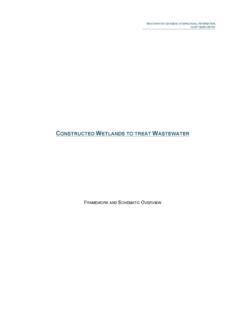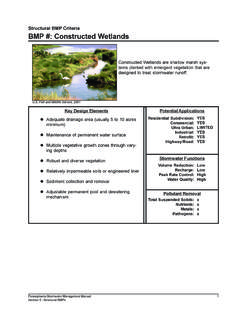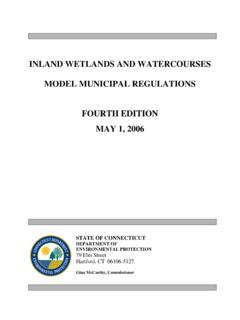Transcription of Constructed Wetlands Systems: Alternative Design Approaches
1 Constructed wetland Systems: Constructed wetland Systems: Design ApproachesDesign ApproachesScott D. Wallace, PresidentNorth American wetland Engineering Curriculum Development forDecentralized Wastewater ManagementNDWRCDP DisclaimerNDWRCDP DisclaimerThis work was supported by the National Decentralized Water This work was supported by the National Decentralized Water Resources Capacity Development Project (NDWRCDP) with Resources Capacity Development Project (NDWRCDP) with funding provided by the Environmental Protection Agency funding provided by the Environmental Protection Agency through a Cooperative Agreement (EPA No. CR827881through a Cooperative Agreement (EPA No. CR827881--0101--0) 0) with Washington University in St. Louis. These materials have with Washington University in St. Louis. These materials have not been reviewed by the Environmental Protection not been reviewed by the Environmental Protection Agency.
2 These materials have been reviewed by Agency. These materials have been reviewed by representatives of the NDWRCDP. The contents representatives of the NDWRCDP. The contents of these materials do not necessarily reflect the views and of these materials do not necessarily reflect the views and policies of the NDWRCDP, Washington University, or the policies of the NDWRCDP, Washington University, or the Environmental Protection Agency, nor does the mention of trade Environmental Protection Agency, nor does the mention of trade names or commercial products constitute their endorsement or names or commercial products constitute their endorsement or recommendation for for DisclaimerCIDWT/University DisclaimerThese materials are the collective effort of individuals from These materials are the collective effort of individuals from academic, regulatory, and private sectors of the academic, regulatory, and private sectors of the onsite/decentralized wastewater industry.
3 These materials have onsite/decentralized wastewater industry. These materials have been peerbeen peer--reviewed and represent the current state of reviewed and represent the current state of knowledge/science in this field. They were developed through a knowledge/science in this field. They were developed through a series of writing and review meetings with the goal of formulatiseries of writing and review meetings with the goal of formulating ng a consensus on the materials presented. These materials do not a consensus on the materials presented. These materials do not necessarily reflect the views and policies of University of necessarily reflect the views and policies of University of Arkansas, and/or the Consortium of Institutes for Decentralized Arkansas, and/or the Consortium of Institutes for Decentralized Wastewater Treatment (CIDWT). The mention of trade names or Wastewater Treatment (CIDWT). The mention of trade names or commercial products does not constitute an endorsement or commercial products does not constitute an endorsement or recommendation for use from these individuals or entities, nor recommendation for use from these individuals or entities, nor does it constitute criticism for similar ones not it constitute criticism for similar ones not , 2005.
4 Constructed Wetlands : Wallace, 2005. Constructed Wetlands : Design Approaches Design Approaches --PowerPoint Presentation. PowerPoint Presentation. inin( Gross and Deal, eds.) University ( Gross and Deal, eds.) University Curriculum Development for Decentralized Curriculum Development for Decentralized Wastewater Management. National Wastewater Management. National Decentralized Water Resources Capacity Decentralized Water Resources Capacity Development Project. University of Arkansas, Development Project. University of Arkansas, Fayetteville, , of Constructed WetlandsTypes of Constructed Wetlands Free Water Surface (FWS)Free Water Surface (FWS) Vegetated Submerged Bed (VSB)Vegetated Submerged Bed (VSB) Vertical Flow (VF)Vertical Flow (VF)Free Water Surface WetlandFree Water Surface wetland FWS Wetlands have FWS Wetlands have exposed water bodies exposed water bodies similar to natural similar to natural Water Surface WetlandFree Water Surface WetlandFWS wetland operating near Pensacola, FloridaPhoto courtesy S.
5 WallaceFree Water Surface WetlandFree Water Surface wetland Typical applications are for polishing effluent from Typical applications are for polishing effluent from a lagoon, activated sludge, or other secondary a lagoon, activated sludge, or other secondary treatment processtreatment processVegetated Submerged BedVegetated Submerged Bed VSB Wetlands employ a gravel bed planted with VSB Wetlands employ a gravel bed planted with wetland vegetation. The water is kept below the wetland vegetation. The water is kept below the surface of the of the Submerged BedVegetated Submerged BedVSB wetland operating near Lindstrom, MinnesotaPhoto courtesy North American wetland EngineeringVSB WetlandsVSB Wetlands Most commonly used for onsite wastewater Most commonly used for onsite wastewater treatment for singletreatment for single--family homesfamily homesVertical Flow WetlandsVertical Flow Wetlands VF Wetlands have much higher oxygen transfer VF Wetlands have much higher oxygen transfer rates, allowing for , allowing for nitrification.
6 2 Design types:2 Design types:zzRecirculating (more common in US)Recirculating (more common in US)zzSingleSingle--pass (more common in Europe)pass (more common in Europe)Recirculating VF wetland schematic courtesy Reactor Dynamics wetland ProcessesFWS wetland Processes Flow governed by Manning s EquationFlow governed by Manning s Equation21321()()wvdsn=v = liquid flow velocity, ft/sn = Manning s coefficient s/ft1/3dw= depth of water in wetland , fts = hydraulic gradient or slope of the water surface ft/ftCrites & Tchobanoglous, 2002 FWS wetland ProcessesFWS wetland Processes Manning s coefficient a function of the Manning s coefficient a function of the density of the vegetation and flow depthdensity of the vegetation and flow depth2wand=a = resistance factor, 16sft < very dense moderately dense vegetation> for sparse vegetationWater depth, dwResistance Factor, aCrites & Tchobanoglous, 20021 FWS wetland ProcessesFWS wetland Processes Evapotranspiration in FWS is generally Evapotranspiration in FWS is generally estimated as 80% of pan evaporationestimated as 80% of pan evaporationKadlec& Knight.
7 1996 Role of Plants in FWS WetlandsRole of Plants in FWS sedimentation by reducing water column mixing and surface area in the water column to increase biofilm biomass and pollutant uptake. the removal of particles from the water column by increasing biofilm and plant surfaces available for particle shade from the plant canopy over the water column to reduce algae and preserving duckweed fronds which greatly limit reaerationand light penetration into the water cause flocculation of smaller colloidal particles into larger, settleable Knight Mertz, 2000; USEPA, 2000 Oxygen Transfer in FWS Oxygen Transfer in FWS WetlandsWetlandsOxygen is supplied to the FWS wetland through three passive (algae) oxygen transferFWS Wetlands can also be mechanically aerated to increase of Algae photosynthesis on dissolved oxygen levelsMara, 1976 Suspended Solids Removal in FWS Suspended Solids Removal in FWS WetlandsWetlands Sedimentation (discrete particle settling)Sedimentation (discrete particle settling) Aggregation (flocculation)Aggregation (flocculation) InterceptionInterception PredationPredationRemoval mechanisms predominate in emergent Removal mechanisms predominate in emergent vegetation zones.
8 About 80% of the influent TSS vegetation zones. About 80% of the influent TSS can be removed within a 2can be removed within a 2--day retention time day retention time (USEPA, 2000)(USEPA, 2000)Solids Generation in FWS Solids Generation in FWS wetlandswetlands Resuspension (carp, nutria, etc)Resuspension (carp, nutria, etc) Production (algae blooms)Production (algae blooms)Generation mechanisms predominate in open Generation mechanisms predominate in open water zones. Retention time in open water zones water zones. Retention time in open water zones should be kept to less than 2should be kept to less than 2--3 days per zone to 3 days per zone to avoid algae blooms (USEPA, 2000)avoid algae blooms (USEPA, 2000)Organic Matter DegradationOrganic Matter Degradation In FWS Wetlands , there is large amount of internal In FWS Wetlands , there is large amount of internal carbon cyclingcarbon cyclingKadlec& Knight, 1996 Organic Matter DegradationOrganic Matter Degradation Type of decomposition depends on Type of decomposition depends on organic loading and oxygen transfer rateorganic loading and oxygen transfer rate Loadings that exceed oxygen transfer Loadings that exceed oxygen transfer result in anaerobic conditions in the result in anaerobic conditions in the favorable mosquito habitatMore favorable mosquito habitatOrganic Loading Rates for FWS Organic Loading Rates for FWS WetlandsWetlands150-300200 Semi-plug flow with step feed, 2:1 recycle and supplemental aeration100-200150 Semi-plug flow with 2.
9 1 recycle and step feed50-20060 Semi-plug flowRangekg/ha dTypicalLoadingkg/ha dFWS TypeTchobanoglous, 1987 Nitrogen Cycling in FWS Nitrogen Cycling in FWS WetlandsWetlandsKadlec& Knight, 1996 Nitrogen ProcessesNitrogen Processes MineralizationMineralizationzzConvert organic nitrogen to ammonia (NHConvert organic nitrogen to ammonia (NH44++)) NitrificationNitrification+Nitrosomonas+ -+4222 Nitrobacter--223+-4232NH+ +2H+HONO+ +2 ONO+2H+HO DenitrificationDenitrification()23222646 26 CHONOCONHO + ++(Where CH2O represents biodegradable organic matter.)Nitrogen Removal in FWS Nitrogen Removal in FWS WetlandsWetlands Nitrification has to occur followed by Nitrification has to occur followed by denitrificationdenitrification Only areas in FWS with adequate oxygen Only areas in FWS with adequate oxygen transfer for nitrification are open water transfer for nitrification are open water zoneszones Emergent vegetation zones will create a Emergent vegetation zones will create a reducing environment suitable for reducing environment suitable for denitrification, assuming adequate organic denitrification, assuming adequate organic carbon is availablecarbon is available Highly temperatureHighly temperature--dependent processdependent processFWS Configuration with Open FWS Configuration with Open Water ZonesWater ZonesUSEPA, 2000 Phosphorus Cycling in FWS Phosphorus Cycling in FWS WetlandsWetlands Initially, phosphorus will be removed by Initially.
10 Phosphorus will be removed by adsorption onto sedimentsadsorption onto sedimentszzFinite amount of adsorption sitesFinite amount of adsorption siteszzOnly a temporary removal mechanismOnly a temporary removal mechanism Phosphorus will be cycled through plant Phosphorus will be cycled through plant biomassbiomasszzSince wetland can only support a finite Since wetland can only support a finite standing stock of biomass, removal limited standing stock of biomass, removal limited unless wetland is very largeunless wetland is very largeConsequently, phosphorus removal is minimal under normal loading scenariosPathogen Reduction in FWS Pathogen Reduction in FWS WetlandsWetlands Pathogens are removed through Pathogens are removed through sedimentation, adsorption, interception sedimentation, adsorption, interception and predation. However, pathogens are often reHowever, pathogens are often re--introduced back in the wetland by introduced back in the wetland by waterfowl and other wildlifewaterfowl and other wildlife Disinfection of FWS effluent often required Disinfection of FWS effluent often required to meet surface water discharge standardsto meet surface water discharge standardsMosquito Management in FWS Mosquito Management in FWS WetlandsWetlands FWS Wetlands provide suitable habitat for FWS Wetlands provide suitable habitat for mosquitoesmosquitoes Design goal is to create an environment Design goal is to create an environment where larvae do not survive to become where larvae do not survive to become adult mosquitoesadult mosquitoes Access of predator organisms (fish, water Access of predator organisms (fish, water insects) to larvae is critical to effective insects)






